A new set of guidelines of racing etiquette has been issued to Formula E drivers after concerns were raised about a purported lack of detail and clarity in previous directives, primarily around moving under braking and engagement in wheel-to-wheel racing with competitors.
The Race revealed last month that a meeting between some drivers and Formula E race director Marek Hanaczewski had taken place at the Jakarta E-Prix last month. That appears to have triggered a new document that has circulated among drivers and is believed to have been distributed at the drivers' briefing in Berlin on Friday.
That follows the publication of Formula 1's driving guidelines last month, which have been in use for years.
The FIA described the intention of the guidelines as "assist stewards in reaching fair and consistent decisions in relation to on-track incidents and infringements".
They have been "specifically adapted to the particularities" of Formula E.
"This tailor-made framework ensures that driving conduct aligns with the unique demands and spirit of the championship," FIA President Mohammed Ben Sulayem said.
Speaking before the briefing, Nissan’s Oliver Rowland told The Race that drivers “have a whole new set of guidelines for racing, which is something that I've been asking for a long time.
“I’ve read the initial parts of it, which seem pretty okay, but we needed it,” added Rowland.

“I mean, looking at Jakarta with my incident, I got five seconds for nothing, and then other races, people don't take any penalties, so we need those guidelines to help the stewards make the right decisions.
“I think it'll be a case of adapting them based on experience. But at least now we have something that clearly states what is what. Before it was like, ‘that’s racing sometimes,’ but depending on which steward you have.
“So, I think now it’s very clear whose corner is whose and how they're going to manage that. I think it's a good thing. Of course, it won't be perfect, there'll be bits we'll need to tweak, but I think at least it's a good step in the right direction.”
But Lola Yamaha ABT's Lucas di Grassi told The Race that he would remain cautious until the new guidelines are formally discussed, saying that any rules needed to contain ‘common sense’ and had to find ‘the right wording and the right incentives.”
“Yes they share these guidelines with us, new guidelines,” di Grassi confirmed to The Race.
“But the problem with something like this is that you cannot be black and white on the result because you don't have a strict environment that you can control exactly.
“It always goes back to common sense. When you do something like this, you always create a new problem. So regardless of what you're trying to do, you're always going to create another issue.
“If you say we can be side by side, only if the mirror is in the same direction, what if the mirror is two millimetres to the back or to the front? If you try to create a rule in this environment, it always can create another problem that you can discuss.
“So, what we have to be careful of is not to create more problems than solving them. We have to find the right wording and the right incentives that essentially gives the drivers the clearest behaviour traits during the race. That's what we're trying to do. And at the moment, I think there's still margin to improve.”
Blue flag suspension in Berlin
Blue flags will be suspended for a period in the first Berlin E-Prix on Saturday, which will feature the pit boost pit-stops.
This will occur in the official pit window, which is mandated between 60% and 40% of the minimum state-of-charge of the battery.
The pit boost time is expected to be around the 60-second mark at the airfield track, which is similar to what is expected to be the average laptime with the quicker Gen3Evo spec cars, which should lap in and around the 60-second mark in dry running.
This measure has been made to try and limit confusion should cars be about to or actually go a lap down.
“This (suspension) is just for four laps,” di Grassi told The Race.
“There will be a bit of confusion, and then everybody settles again because the (pit) window is quite narrow. If the window was the whole race, it could have been chaotic because you never know who's in front, who's in the back. But only because of these four or five laps you have in the middle.”



